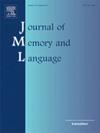Protecting the innocent in eyewitness identification: An analysis of simultaneous and ranking lineups
IF 3
1区 心理学
Q1 LINGUISTICS
引用次数: 0
Abstract
In an effort to protect innocent suspects in police lineups, guidelines tend to encourage conservative responding in eyewitnesses. We used Signal Detection Theory (SDT), in conjunction with Expected Information Gain (EIG), to explain why conservative responding with standard simultaneous lineup procedures is detrimental to gathering information about the guilt or innocence of suspects. We also show that a different lineup procedure, the ranking lineup, should largely avoid this loss of information. These SDT predictions were tested in two experiments that manipulated response conservativeness in terms of instructions to the witness and/or witness confidence levels. The results showed strong evidence for the predicted pattern. That is, conservative responding substantially decreased the information value of witness responses in simultaneous lineups, but not ranking lineups. Critically, conservative responding in the simultaneous procedure specifically decreased the ability to gain evidence of innocence, revealing a cost that offsets the benefit of reduced false identifications. The ranking procedure, in contrast, provided strong evidence of innocence even when false identification rates were low. These results have significant implications for policy recommendations in police lineups and suggest that eyewitness researchers need to consider information-theory measures in the attempt to find procedures that best serve the goal of protecting innocent suspects.
在目击证人辨认中保护无辜者:同步排查和排序排查分析
为了在警方排查中保护无辜的嫌疑人,指导方针倾向于鼓励目击者做出保守的反应。我们利用信号检测理论(SDT)与预期信息增益(EIG)相结合,解释了为什么标准的同时列队程序中的保守反应不利于收集疑犯有罪或无罪的信息。我们还证明,不同的列队程序--排序列队--应能在很大程度上避免这种信息损失。这些 SDT 预测在两个实验中得到了验证,这两个实验通过对证人的指示和/或证人的信心水平来操纵反应的保守性。结果显示,预测的模式得到了有力的证明。也就是说,在同时列队中,保守的回答会大大降低证人回答的信息价值,而在排序列队中则不会。重要的是,在同时排查程序中,保守的回答明显降低了获得无罪证据的能力,显示出一种成本抵消了减少错误指认所带来的收益。与此相反,即使错误指认率很低,排序程序也能提供有力的无罪证据。这些结果对警方排查中的政策建议具有重要意义,并表明目击者研究人员需要考虑信息理论措施,试图找到最有利于保护无辜嫌疑人的程序。
本文章由计算机程序翻译,如有差异,请以英文原文为准。
求助全文
约1分钟内获得全文
求助全文
来源期刊
CiteScore
8.70
自引率
14.00%
发文量
49
审稿时长
12.7 weeks
期刊介绍:
Articles in the Journal of Memory and Language contribute to the formulation of scientific issues and theories in the areas of memory, language comprehension and production, and cognitive processes. Special emphasis is given to research articles that provide new theoretical insights based on a carefully laid empirical foundation. The journal generally favors articles that provide multiple experiments. In addition, significant theoretical papers without new experimental findings may be published.
The Journal of Memory and Language is a valuable tool for cognitive scientists, including psychologists, linguists, and others interested in memory and learning, language, reading, and speech.
Research Areas include:
• Topics that illuminate aspects of memory or language processing
• Linguistics
• Neuropsychology.

 求助内容:
求助内容: 应助结果提醒方式:
应助结果提醒方式:


